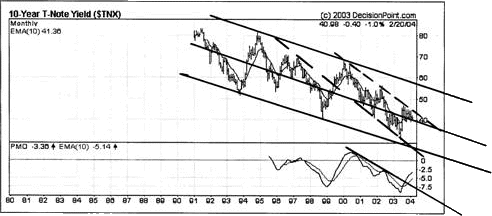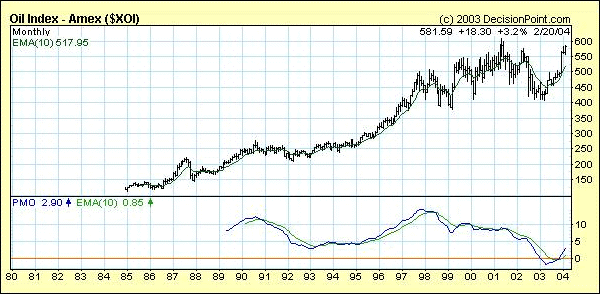Secrets
Come on Mr Market! Talk to me! What secrets are you hiding?
For about two hours I have been scrolling through the monthly charts to get a feel for the big picture. With a contrived mindset of neutralised prejudices, the most significant charts that jumped out at me were the yield charts below.
The 30 year yield chart has been following a constant angle of decline (within various channel lines) since 1989. Ie. The 30 year yield has been in a Primary Bear trend for around 15 years, and there is no sign that this is about to change. (Source: DecisionPoint.com).
Furthermore, as the yield is in the upper quadrant of the channel, the probabilities (based on history) favour a fall rather than a rise from this point.

The 10 year yield has also been travelling in a similarly angled downward pointing channel which began to become recognisable in around 1995. Here also, a case might be made that the 10 year yield could be riding for an imminent fall

Note that the 10 year yield has recently been travelling within a channel that has a steeper angle of decline, and that the yield is being squeezed into the apex of a triangle being formed by the two competing angles of decline, and from which it "might" break down. However, the PMO's break to the upside in mid 2003 supports the view that this yield "might" break up from the apex (within the confines of the shallower decline).
In context of the following chart - which shows very little downside potential for the short yields - it could be further argued that the 10 year yields have a greater chance of breaking up than down.

Whilst the angle of decline of the 3 month T Bill yield has been similar to that of both the 30 year yield and the 10 year yield, the 3 month yield is currently bouncing up off the lower trendline, and the PMO is giving a buy signal (see arrow).
What to make of all this??
Well, of great interest to me is the relative levels of the 30 year and 10 year yields viz 4.953% for the 30 year yield vs 4.098% for the 10 year yield as at February 20th 2004.
The yield differential (the difference between the two) typically implies a built in compensation for inflation. If the 30 year yield is close to the upper boundary of its trendline (implying low potential for further rises unless the Primary Trend reverses to become bullish (bearish for bonds)) - and if both the 10 year yield and the 3 month yield "could" break up from these levels - then, what will start to manifest is a narrowing of the yield differential.
Now, why would anyone invest at (say) 4.5% in BOTH a 30 year bond and a 10 year bond?
There is only one possible reason, and that is that the market is anticipating a decline in inflation, and there is a potential convergence of the "time value" of both 10 year and 30 year money. If inflation goes away, then investors will be indifferent regarding long dated and medium dated Treasury yields. Indeed, it could even be argued that 10 year yields might rise ABOVE 30 year yields in the event that deflation sets in. Let's let our imaginations soar for the moment.
What is the biggest potential risk facing the financial markets at present?
Well, between a possible derivative implosion and a possible debt implosion it's a close call.
But what if …? What if the really big markets (Treasuries and Currencies) trended sideways from here?
From JP Morgan's perspective - as an example - many (possibly most) of the derivatives contracts on their books would expire "out of the money". (HUGE sigh of relief!)
From the point of view of lending banks in general, a squeeze in yield differentials might eat into their profit margins, but a reduction in interest rate volatility might ameliorate the risk of non performing loans. Perhaps a higher yield margin could be charged in order to compensate for the lower VOLUME of activity. (OK so far)
What about the property markets?
If inflation went away, the "commercial" and "industrial" property markets might still be OK. Most landlords try to build in a rental escalation based on a fixed percentage rise or a percentage above CPI. This might put some tenants in difficulties, but "deals" could be worked out in cases of need. In short, capital values of property would certainly stop rising, but they might not fall if occupancy rates could be maintained, and interest rates put both a cap and a floor under capitalisation rates.
If "domestic" property owners were not put under pressure to pay higher rates of interest or higher rates of debt paydown, then domestic property prices might also trend sideways for a while.
Are the markets giving any other signals that inflation might be going away?
Let's look at gold:

Those amongst us who are objectively honest could happily accept the argument that $400/ounce appears to be a "pivot" level around which the gold price has been moving (virtually sideways) for around 20 years. The PMO is also pointing to a possible peak in gold at around $400 for the time being - leading to a possible rise to around $500 - $550 an ounce after some consolidation. (It could be argued that Central Bank intervention between 1995 and 2003 has had the effect of inhibiting gold's price rise to date, and a rise to as high as $550 might be more related to "catch up" than to inflation going forward).
How about commodities?

From the above chart it can be seen that the Commodities index has been batting around between 275 and 200 since 1983. Yes, there was a period of weakness from mid 1998 to 2002, but an argument could be put forward that this, too, was an aberration given that the US dollar was extraordinarily (and contrivedly) strong during that period, and that 275 to 285 might now represent a peak for the commodities index if the US dollar flattens out relative to other currencies.
Let's look at the US Dollar's long term chart.

Here too - except for a few years during the Clinton era where the dollar was kept artificially high - the dollar index has been batting around between 80 and 100 since 1987. With the PMO nearing its lows, the downside potential for the dollar might be fairly limited from this point - but the dollar does not necessarily need to rise for the PMO to rise. It could trend sideways.
Let's look at the Euro:

Except for the "strong dollar" period, the Euro has been batting around between 100 and 140, and could ALSO be approaching resistance (just as the US Dollar is approaching support)
Only the US Stock market (see previous two essays) looks like it might experience some volatility at this point, but this view might also stem from a prejudicial mindset.
Clearly, the US equity market is overvalued at P/E ratios that are close to 30X. Equally clearly, the market is overbought and at or near a peak within the confines of a Primary Bear Market. But does it therefore follow that the market has to fall from here? Might it not trend sideways for a decade or so until earnings catch up?
Conventional wisdom would argue that there needs to be a second "panic" down-leg in the market. But an argument could be put forward that most money currently in the market is 401k based. It might be "dumb" money, but it is not "speculative" money per se. People who have invested their money in the markets via retirement funds might choose to hang in there for the long haul and just "sit" (as opposed to panic out). After all, investments in equities to date have not been predicated on income.
Conclusions
From the perspective of the world's Central Bankers, a "best case" scenario would be if the forces of inflation/deflation remained neutrally balanced, thereby facilitating a sideways trending of Treasury yields, Currencies and Equities markets for the foreseeable future.
Under such circumstances, the following outcomes might be anticipated:
The derivatives overhang would evaporate as contracts expired "out of the money"
The quality of bank loans would remain manageable, whilst bank profits might be augmented by higher margins
Property markets might tread water (neither rising nor falling)
Equities markets might tread water whilst earnings grew into P/E ratios
At this point in time, the long term charts appear to support the possibility of an outcome such as contemplated above.
Going forward under such a scenario, wealth will have to be earned by sweat and/or intellectual input, and the problem stretching out into the future seems more likely be "income" related than "capital" related.
In short, the most important unanswered question now is : "How are the baby boomers going to continue to support the lifestyles to which they have become accustomed?"
Post Script:
Unfortunately, the above scenario is not supported by the following chart of the oil index:

To my way of thinking, this chart reflects the largest single risk to the world's financial markets.
If the oil price breaks up into new territory - which it could do given the recent PMO buy signal of the oil index - there might very well be a concomitant "panic" down-leg on the equity markets.
Mr Richard Russel is one of the few men alive who have the ability to penetrate all the static and "hear" what the markets are really saying. His PTI appears to have hit a double top, and he has been pointing his readers to a possible topping out of the equities markets and to the flagrant non-confirmation of the Dow Transports of the movement in the Dow Jones Industrial Index.
The above chart might explain why the Transports have been trending southwards. Further, it represents very compelling evidence that the real underlying reason for the attack on Iraq was to neutralise the risk to the world's financial infrastructure.
And it didn't work! The oil price was supposed to fall following the attack on Iraq. That, after all is said and done, is what Mr Rupert Murdoch actually said in an interview.
Right now, the "oil price" is the biggest issue. As an oil man, George W Bush understands this, if he understands nothing else.
Right now, the Dow Transports - having failed to rise to new highs in conjunction with the DJIA - are screaming a warning signal:

When all is said and done, "Gold" is an insurance policy against the failure of the Central Banks to deliver on their plans.
To quote Mr Robert Burns:
"The best laid schemes o' mice an' men Gang aft a-gley"
I'll stick with my gold and silver investments.
















